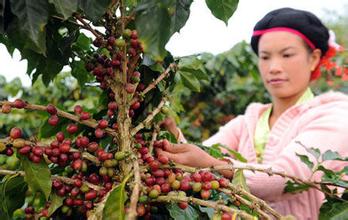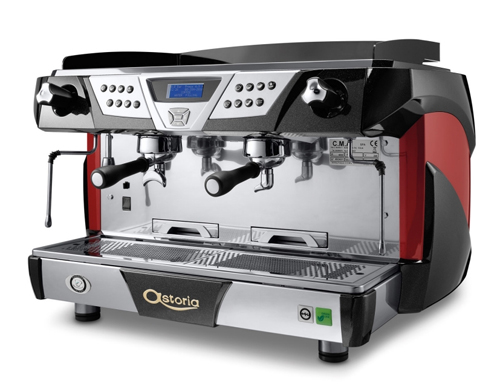The harvest and processing flow and two basic processing methods of coffee beans in India and West Asia.
Picking: Due to climate differences, harvest season usually runs from September to March in the Northern Hemisphere and from April to August in the Southern Hemisphere. When the coffee beans are ripe, they can be picked. In many mountain slopes, coffee must be picked by hand. In relatively flat regions such as Brazil, Australia and Hawaii, picking can be done by machine. These two methods, obviously, manual picking costs are higher, but the advantage is that you can ensure that the picking is ripe fresh fruit, avoid picking other debris, and because the maturity of coffee fruit is different, manual picking can be done several times the same tree, this is also a key step to obtain high-quality coffee. Machine picking, on the other hand, will pick the whole tree of fresh coffee regardless of maturity or immaturity, even with leaves and branches will be pulled down. Relatively rough.
Treatment method: This is one of the basic treatment methods of coffee fruit, which is also called natural drying or non-washing. Especially in Africa and other water-poor regions, almost all use solarization. Dry the coffee fruit directly until the whole fruit is dry, and then remove the peel and pulp to obtain coffee beans. In the past, coffee farmers were drying in the open space of their own yard, which was rough and a little careless, and the coffee would be stained with impurities. However, with the improvement of coffee production technology, people in some producing areas began to use off-the-ground drying, which greatly reversed the image of sun-dried coffee. Sun-cured coffee is much more mellow and sweeter. Usually, when the coffee fruit is dried, it is put into a mill to remove the skin and pulp, and the coffee beans with silver skin are directly obtained, and then sent to the processing plant for further classification and selection.
Treatment method 2 washing treatment method-1 cleaning separation coffee beans: picking fresh coffee into the pool cleaning, mature fruit and floating on the surface of the leaves, debris, immature fruit and over-ripe fruit separated.
Washing treatment method-2 remove the peel and pulp: clean fresh coffee into the peel machine to remove the peel.
Coffee beans with their husks removed.
Washing method-3 fermentation: Because the shelled coffee beans after removing the peel are also covered by a layer of mucosa (also known as "pectin") that cannot be dissolved in water, these coffee beans are piled up and fermented, which will quickly decompose the mucosa and make it easy to be washed away by water. The beans can be fermented wet in a fermentation tank immersed in water or dry without soaking. The length of fermentation depends on the fermentation temperature, coffee type, coffee quantity and ripeness of the fruit. In most areas, fermentation takes an average of 12-36 hours.
Washing method-4 cleaning with shell beans: once fermentation is over, it must be washed immediately, the washing water must be flowing water, healthy mature coffee beans will remain at the bottom of the pool, defective coffee beans will float on the surface of the water, after the washing process, coffee endocarp (also known as parchment) still exists.
Washing treatment method-5 drying: washed beans with shells need to be dried, usually in the open air, coffee beans need to be constantly turned to prevent unnecessary fermentation. But do not dry too fast, gradually to dry, otherwise, will cause coffee beans to crack and lose aroma.
Shed drying in Colombia to avoid drying too fast due to too much sun burst.
Sometimes due to weather or workload, large coffee processing plants will use machines to dry.
Shelling: At this time, the parchment shell is removed by the machine, and the strong airflow in the machine can blow away impurities and clean the coffee beans again.
Grading: The coffee beans after shelling are subjected to various grading procedures such as weight comparison and size screening. Usually, the more thorough these procedures are, the better the quality of the coffee will be. (From this point on, beans, whether sun-dried, washed or otherwise, will undergo the same sorting process.)
Selection: This is the final process of packaging coffee beans before export. Most coffee beans go through this process, and the more careful the selection process is, the fewer defective beans there are. Only such careful selection can guarantee the high quality of the final coffee.
A coffee worker selects coffee beans in Indonesia.
Weighing and packaging: The final green coffee beans are weighed and packed into bags. The packaging size common in most countries of origin is 60kg/bag. A few countries use 70kg/bag specifications.
Some small estates accept custom production, so 30kg/bag packaging specifications are also used.
Coffee beans packaged for export.
Solarization and washing are two basic treatments. Relatively speaking, the solarization process is a lot simpler, so from the perspective of commercial beans, the price of solarization has been lower than that of washed coffee beans, and the status is relatively low. However, these years, there are also some processing plants that can produce high-quality sun-dried coffee beans, such as fine-grade sun-dried yejia sherry, which has a very high sweetness, rich floral aroma and body, once subverting the practice of washing beans better. Of course, such exquisite sunburn style is still a minority. The washed coffee beans have higher acidity, clean taste spectrum and elegant fragrance. Most of the fine coffee beans are still mainly washed.
Source:
EPC Private Roast Coffee Blog
Important Notice :
前街咖啡 FrontStreet Coffee has moved to new addredd:
FrontStreet Coffee Address: 315,Donghua East Road,GuangZhou
Tel:020 38364473
- Prev

Detailed analysis and introduction of the operation techniques of coffee beans from picking to raw bean treatment.
Coffee bean processing: coffee berries must be processed immediately after picking to prevent pulp fermentation and decay. Coffee beans can be processed in two ways, wet and dry. The drying method is also called the natural method. Spread the coffee berries flat in the sun to dry. In the plantation, 50 square meters of coffee berries are spread on each hectare, or the fruit is placed in a special
- Next

English tips on coffee machine coffee category to help you understand the common coffee machine English tips
To help you understand the English hint of the coffee machine SELECT PRODUCT READY FOR USE, this is the normal state in which you can make coffee. Choose the kind of coffee you like and press the button. There is a problem or blocking in the BREWUNIT BLOCKED puffing group. If you need to clean and check and return to your place, it is recommended to contact the maintenance personnel on the manual. There is an error in the BREWUNIT MISSING puffing group. Position
Related
- What is the meaning of lactic acid fermentation with coffee bean treatment?
- How to judge the state of foam by sound?
- How does the latte pull out the unicorn pattern? Come to get for a little trick to improve the flower pull!
- Will flower pulling affect the taste of the latte?
- Do you know the history of coffee?
- The difference between honey treatment and sun washing what is raisin honey treatment?
- What kind of milk can a novice use to make coffee foam to keep the foam longer? The correct method and skills of milking tutorial sharing
- Why do washed coffee beans taste sour? Flavor characteristics of washed Coffee
- Introduction to the skill of how to practice the size and height of water injection around the circle of hand-brewed coffee
- How do beginners practice coffee flower drawing from scratch?

